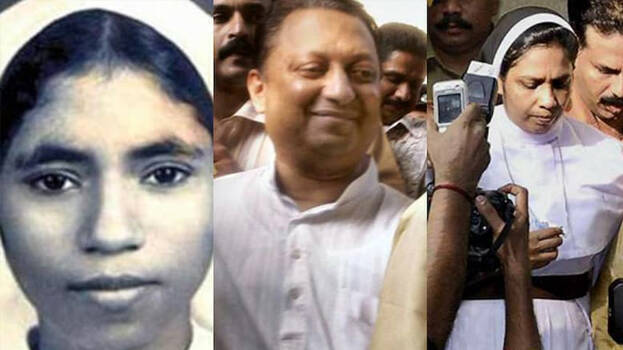

In people’s conscientious mind, the Abhaya case has been a smouldering ember. A CBI court here on Tuesday found a catholic priest and a nun guilty in connection with the murder of 21-year-old Sister Abhaya, whose body was found in the well of a convent in Kottayam in 1992.
The verdict in this regard was pronounced by CBI special court judge J Sanal Kumar.
The quantum of sentence will be pronounced on Wednesday. The court said the murder charges against Father Thomas Kottoor and Sister Sephy guilty would stand. Both are in judicial custody.
Another accused in the case, Father Poothrakayal was discharged earlier over lack of evidence. The judgement comes 28 years after the young nun was found dead in the well of St Pius convent, where she stayed.
Abhaya's parents Thomas and Leelamma passed away few years ago awaiting justice for their daughter. First local police and then crime branch investigated and concluded that it was a case of suicide.
The CBI took over the investigation of the case in 2008. The trial in the case began on August 26 last year and many witnesses had turned hostile.
According to prosecution, Abhaya was attacked with the handle of an axe because she was witness to some alleged immoral activity involving the three accused.
Thomas Kottur had been charged with murder (Section 302 of IPC), Destruction of Evidence (201 IPC) and 449 (house trespass). Sephy has been charged under Sections 302 and 201.
Despite the absence of witnesses, the CBI’s prosecution lawyer was able to prove the case diligently and convinced the court. Now what lies in store for the convicts is the maximum punishment stipulated by the law.
This will be an embarrassment for people who tried to protect the convicts for the last 28 years. The convicts might have thought that it would be necessary to end the life of Abhaya who had bumped into them when they were indulged in acts tantamount to maligning the sanctity of the convent and its legacy.
Despite the interference of many to hush up or close the case, it achieved a happy ending. Behind this there are hard work, dedication, truth and honesty of many persons who didn’t allow the case to die.
Many lawyers, police officers, human activists like Joemon Puthenpurakkal, and even journalists had helped in protecting the case, which was disrupted several times, They gave a new life to the case.
Abhaya case could be a case study for students of law. The final findings show that Truth Cannot ne kept under wraps forever, however attempts are made for it.
Former CBI officer and DySP Varghese P Thomas was the first officer to unhesitatingly state that Abhaya case was a case of murder even when the local police and the Crime branch wrote it off as a suicide case.
He had said that Abhaya was murdered and dumped in the well.
For this audacious and honest officer, it was a long wait of 28 years.
Though most of the witnesses turned hostile, what helped the investigation team led by Varghese P Thomas to ascertain that Abhaya was murdered was scientific evidence.
When the CBI team led by Thomas pulled out her body, upward scratch mark was seen on her lap. This helped the team to come ot the conclusion that Abhaya might have fallen into the well with leg part going down first.
Bruises found on the back side of the lap might have caused as it would have scratched against the wall during the fall into the well.
Normally a person falling into the well in upright position doesn’t injure the centre of the head but that part of Abhaya’s head had 4 inch long wound.
The forensic test result showed that that wound might have been caused hitting her head with some heavy object.
When Thomas P Varghese was about to submit the report, he faced pressure from higher-ups to make it a suicide case. But he was not willing to budge as he always stood for truth. Finally he had to take VRS for the cause of his principles.
As the accused were two priests and a nun, the interference from the administrative power hubs also came to light.
During the trial 8 witnesses turned hostile but still the crime was proved as if there was a signature of God.
It is said that in any case a clue will be left by the guilty at the crime scene and here it was said to be in the form of a thief, who is hated by society.
He had to undergo torture in that name though he was not the guilty. He was beaten up to admit to the crime which he had not done.
But during the trial he stuck to his early stand.
Ironically, he sincerely wanted to see the case reaching a logical conclusion. It is a shame that even his sensitivity was not seen in church leaders, certain police officers and politicians who, on the other hand, wanted to sabotage the case.
Abhaya’s parents who led a long legal battle are no more.
But at least now Abhaya’s only brother and relatives can find relief in the fact the law was able to expose the real culprits.
For Kerala Kumauni also, the verdict gives great joy. From the beginning of the case, we were closely following the case.
It may also be recalled that for writing editorial against the attempts to sabotage the case, we also had to appear in the court.